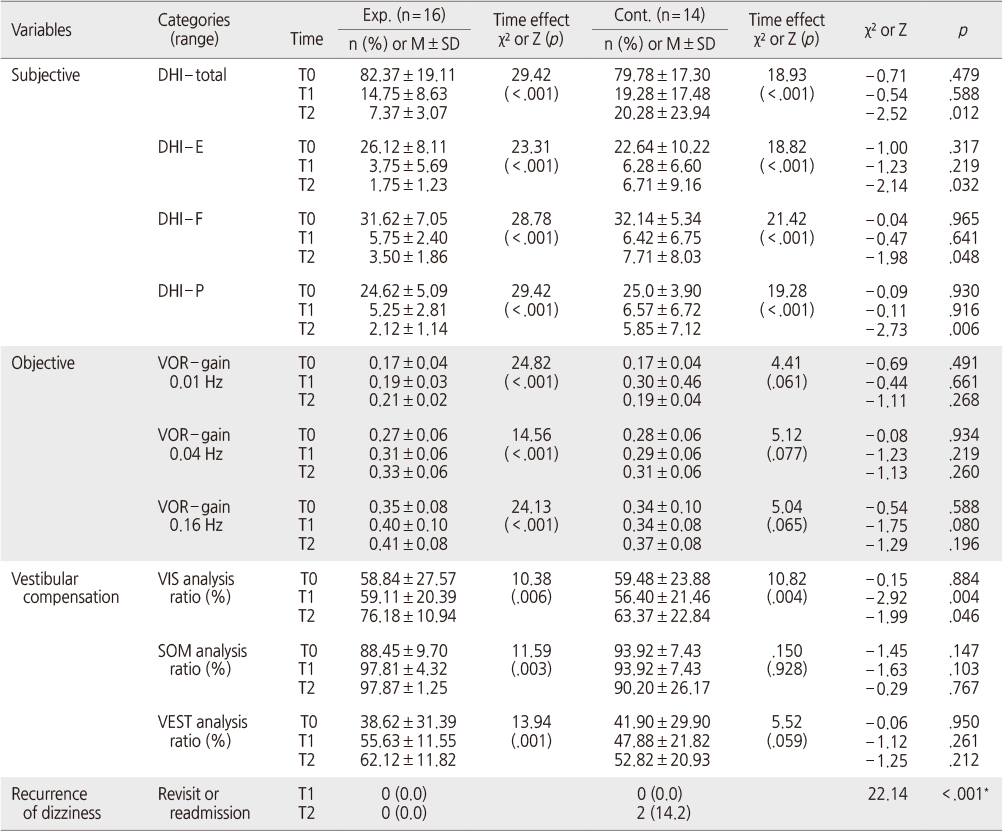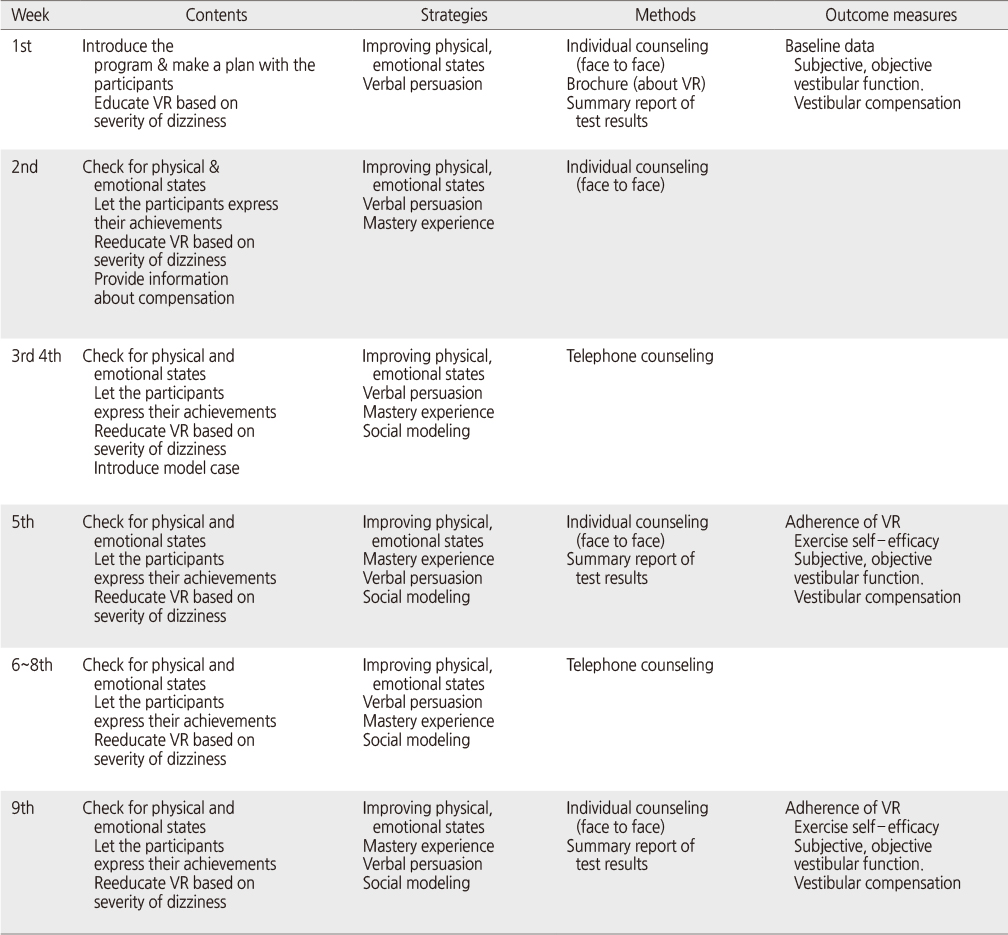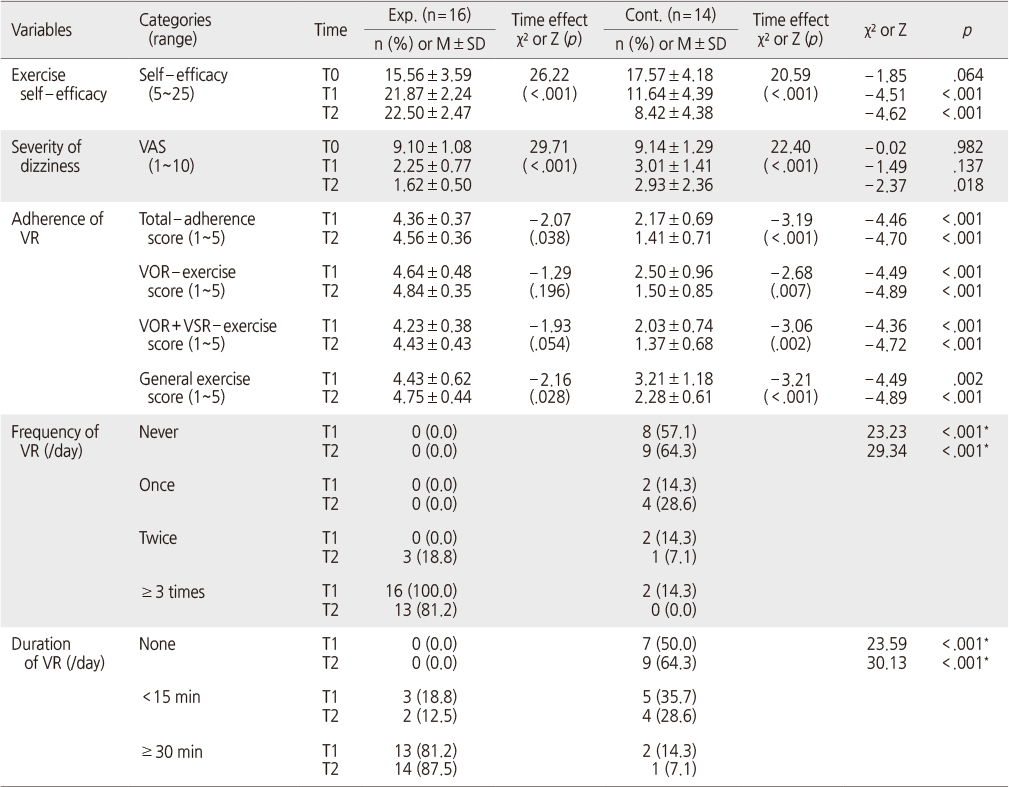Articles
- Page Path
- HOME > J Korean Acad Nurs > Volume 46(5); 2016 > Article
-
Original Article
- Effectiveness of Self-efficacy Promoting Vestibular Rehabilitation Program for Patients with Vestibular Hypofunction
- Hyun Jung Lee, Smi Choi-Kwon
-
Journal of Korean Academy of Nursing 2016;46(5):710-719.
DOI: https://doi.org/10.4040/jkan.2016.46.5.710
Published online: October 31, 2016
1Department of Otorhinolaryngology-Head and Neck Surgery·Vestibular Function Test Lab, Dankook University Medical Center, Cheonan, Korea.
2College of Nursing·The Research Institute of Nursing Science, Seoul National University, Seoul, Korea.
- Address reprint requests to : Choi-Kwon, Smi. College of Nursing, The Research Institute of Nursing Science, Seoul National University, 103 Daehak-ro, Jongro-Gu, Seoul 03080, Korea. Tel: +82-2-740-8830, Fax: +82-2-765-4103, smi@snu.ac.kr
© 2016 Korean Society of Nursing Science
This is an Open Access article distributed under the terms of the Creative Commons Attribution NoDerivs License. (http://creativecommons.org/licenses/by-nd/4.0/) If the original work is properly cited and retained without any modification or reproduction, it can be used and re-distributed in any format and medium.
Abstract
-
Purpose
- In this study an examination was done of the effect of self-efficacy promoting vestibular rehabilitation (S-VR) on dizziness, exercise selfefficacy, adherence to vestibular rehabilitation (VR), subjective and objective vestibular function, vestibular compensation and the recurrence of dizziness in patients with vestibular hypofunction.
-
Methods
- This was a randomized controlled study. Data were collected 3 times at baseline, 4 and 8 weeks after beginning the intervention. Outcome measures were level of dizziness, exercise self-efficacy, and level of adherence to VR. Subjective and objective vestibular function, vestibular compensation and the recurrence of dizziness were also obtained. Data were analyzed using Windows SPSS 21.0 program.
-
Results
- After 4 weeks of S-VR, there was no difference between the groups for dizziness, subjective and objective vestibular functions. However, exercise self-efficacy and adherence to VR were higher in the experimental group than in the control group. After 8 weeks of S-VR, dizziness (p =.018) exercise self-efficacy (p <.001), adherence to VR (p <.001), total-dizziness handicap inventory (DHI) (p =.012), vision analysis ratio (p =.046) in the experimental group differ significantly from that of the control group. The number of patients with recurring dizziness were higher in the control group than in the experimental group (p <.001).
-
Conclusion
- The results indicate that continuous 8 weeks of S-VR is effective in reducing dizziness, and improving exercise self-efficacy, subjective vestibular function and adherence to VR. Objective vestibular function and vestibular compensation were also improved in the experimental group at the end of 8 weeks of S-VR.
The manuscript is a condensed form of the first author's doctoral dissertation from Seoul National University.
This work was supported by Health Fellowship Foundation 2015.
The authors declared no conflict of interest.
- 1. Brevern M, Neuhauser H. Epidemiological evidence for a link between vertigo and migraine. J Vestib Res. 2011;21(6):299–304. ArticlePubMed
- 2. Health Insurance Review & Assessment Service. Cause of dizziness [Internet]. Wonju, Author. 2013;cited 2015 MAR 10. Available from: http://www.hira.or.kr/dummy.do?pgmid=HIRAA020041000000&cmsurl=/cms/notice/02/1214308_13390.html
- 3. Oh SY. Diagnosis and treatment of chronic dizziness. Res Vestib Sci. 2010;9:Suppl 1. S65–S71.
- 4. Sun DQ, Ward BK, Semenov YR, Carey JP, Della Santina CC. Bilateral vestibular deficiency: Quality of life and economic implications. JAMA Otolaryngol Head Neck Surg. 2014;140(6):527–534. ArticlePubMedPMC
- 5. Kim JI. Diagnosis and treatment of chronic dizziness. J Korean Bal Soc. 2007;6(1):93–99.
- 6. McDonnell MN, Hillier SL. Vestibular rehabilitation for unilateral peripheral vestibular dysfunction. Cochrane Database Syst Rev. 2015;1:CD005397ArticlePubMed
- 7. Kao CL, Chen LK, Chern CM, Hsu LC, Chen CC, Hwang SJ. Rehabilitation outcome in home-based versus supervised exercise programs for chronically dizzy patients. Arch Gerontol Geriatr. 2010;51(3):264–267. ArticlePubMed
- 8. Lee DJ, Rhee CK, Suh MW. Rehabilitation of vestibular hypofunction. Res Vestib Sci. 2011;10:Suppl 1. S32–S37.
- 9. Balci BD, Akdal G, Yaka E, Angin S. Vestibular rehabilitation in acute central vestibulopathy: A randomized controlled trial. J Vestib Res. 2013;23(4-5):259–267. ArticlePubMed
- 10. Lee HJ, Choi-Kwon S. Factors influencing adherence to vestibular rehabilitation exercise program in patients with dizziness. Korean J Adult Nurs. 2014;26(4):434–443. ArticlePDF
- 11. Yang JS. Effect of vestibular rehabilitation therapy in peripheral vestibular dysfunction [master's thesis]. Chuncheon, Hallym University. 2007;1–70.
- 12. Bandura A. Self-efficacy: The exercise of control. New York, NY: W. H. Freeman; 1997. p. 1–604.
- 13. Hamid MA. Vestibular rehabilitation. Adv Otolaryngol-Head Neck Surg. 1992;6:27–36.
- 14. Rhee CK. Vestibular rehabilitation. Audiology. 2010;6(1):1–9.ArticlePDF
- 15. Toupet M, Ferrary E, Grayeli AB. Visual analog scale to assess vertigo and dizziness after repositioning maneuvers for benign paroxysmal positional vertigo. J Vestib Res. 2011;21(4):235–241. ArticlePubMed
- 16. Kim HH. The relationship between the therapeutic exercise practice, health beliefs and self-efficacy in patients with restricted shoulder range of motion [master's thesis]. Seoul, Yonsei University. 2007;1–58.
- 17. Jacobson GP, Newman CW. The development of the dizziness handicap inventory. Arch Otolaryngol Head Neck Surg. 1990;116(4):424–427. ArticlePubMed
- 18. Han GC, Lee EJ, Lee JH, Park SN, Lee HY, Jeon EJ, et al. The study of standardization for a Korean adaptation of self-report measures of dizziness. J Korean Bal Soc. 2004;3(2):307–325.
- 19. Kim DH, Lee JH, Kim BJ, Rhee CK, Jung JY. Analysis of clinical features in patients showing bilateral vestibulopathy with vestibular function test. Res Vestib Sci. 2014;13(2):47–52.
- 20. Song SH, Park UY. The effects of figure skating training on equilibrium sensory organization and vestibular-ocular reflex. Exerc Sci. 2013;22(4):319–327.Article
- 21. Murray K, Carroll S, Hill K. Relationship between change in balance and self-reported handicap after vestibular rehabilitation therapy. Physiother Res Int. 2001;6(4):251–263. ArticlePubMed
REFERENCES
Subjective, Objective Vestibular Function, Vestibular Compensation & Recurrence of Dizziness (N=30)

*Fisher's exact test; Exp.=experimental group; Cont.=control group; DHI=dizziness handicap inventory; DHI-E=dizziness handicap inventory-emotion; DHI-F=dizziness handicap inventory function, DHI-P=dizziness handicap inventory-physical; VOR=vestibular ocular reflex; VIS=vision; SOM=somatosensory; VEST=vestibular; T0=pre test; T1=after 4 weeks of intervention; T2=after 8 weeks of intervention.
Figure & Data
REFERENCES
Citations

- Locus of Control and Dizziness: Mediation Effect of Self-Efficacy
Yemo Jeong, Won Hwa Jin, Eun-Jin Kwon, In-Sun Kwon, Han Young Yu, Seong-Hae Jeong
Research in Vestibular Science.2021; 20(4): 126. CrossRef - A Improved Case of Post Cerebral Infarction Dizziness and Gait Discomfort after Treated with Korean Medicine Treatment and Vestibular Rehabilitation Practice
Hongmin Chu, Hyeon-Seo Lim, Kwangho Kim, Young-Ung Lee, Kyungtae Park, Jongwon Jang, Ho-sun Ryu, Su-hak Kim, Cheol-hyun Kim, Sangkwan Lee, Kang-keyng Sung
Journal of Korean Medicine Rehabilitation.2020; 30(4): 179. CrossRef - Awareness about the necessity of vestibular rehabilitation education in Korean physical therapists
Yun-Hee Sung
Journal of Exercise Rehabilitation.2020; 16(2): 197. CrossRef - Improving Balance through Virtual Reality and Physical Therapy Integration
Ben Joseph S. Esguerra, Kristen Johnson
International Journal of Clinical Medicine.2017; 08(05): 322. CrossRef - The Effects of Comprehensive Education Program on Anxiety, Uncertainty and Athletic Performance of Patients undergo Spinal Nerve Block
Seon Hee Kim, Eun Sook Lee
Korean Journal of Adult Nursing.2017; 29(2): 143. CrossRef
Description of Intervention & Outcome Measures
VR=Vestibular rehabilitation.
Baseline Characteristics of the Participants (N=30)
*Fisher's exact test; Exp.=experimental group; Cont.=control group; DHI-E=dizziness handicap inventory-emotion; DHI-F=dizziness handicap inventory-function; DHI-P=dizziness handicap inventory-physical; VOR=vestibular ocular reflex; VIS=vision; SOM=somatosensory; VEST=vestibular.
Comparison of Exercise Self-efficacy, Dizziness & Adherence to VR (N=30)
*Fisher's exact test; Exp.=Experimental group; Cont.=Control group; T0=Pretest; T1=After 4 weeks of intervention; T2=After 8 weeks of intervention; VR=Vestibular rehabilitation; VOR=Vestibular ocular reflex; VSR=Vestibular spinal reflex.
Subjective, Objective Vestibular Function, Vestibular Compensation & Recurrence of Dizziness (N=30)
*Fisher's exact test; Exp.=experimental group; Cont.=control group; DHI=dizziness handicap inventory; DHI-E=dizziness handicap inventory-emotion; DHI-F=dizziness handicap inventory function, DHI-P=dizziness handicap inventory-physical; VOR=vestibular ocular reflex; VIS=vision; SOM=somatosensory; VEST=vestibular; T0=pre test; T1=after 4 weeks of intervention; T2=after 8 weeks of intervention.
VR=Vestibular rehabilitation.
*Fisher's exact test; Exp.=experimental group; Cont.=control group; DHI-E=dizziness handicap inventory-emotion; DHI-F=dizziness handicap inventory-function; DHI-P=dizziness handicap inventory-physical; VOR=vestibular ocular reflex; VIS=vision; SOM=somatosensory; VEST=vestibular.
*Fisher's exact test; Exp.=Experimental group; Cont.=Control group; T0=Pretest; T1=After 4 weeks of intervention; T2=After 8 weeks of intervention; VR=Vestibular rehabilitation; VOR=Vestibular ocular reflex; VSR=Vestibular spinal reflex.
*Fisher's exact test; Exp.=experimental group; Cont.=control group; DHI=dizziness handicap inventory; DHI-E=dizziness handicap inventory-emotion; DHI-F=dizziness handicap inventory function, DHI-P=dizziness handicap inventory-physical; VOR=vestibular ocular reflex; VIS=vision; SOM=somatosensory; VEST=vestibular; T0=pre test; T1=after 4 weeks of intervention; T2=after 8 weeks of intervention.
 KSNS
KSNS
 E-SUBMISSION
E-SUBMISSION



 Cite
Cite

